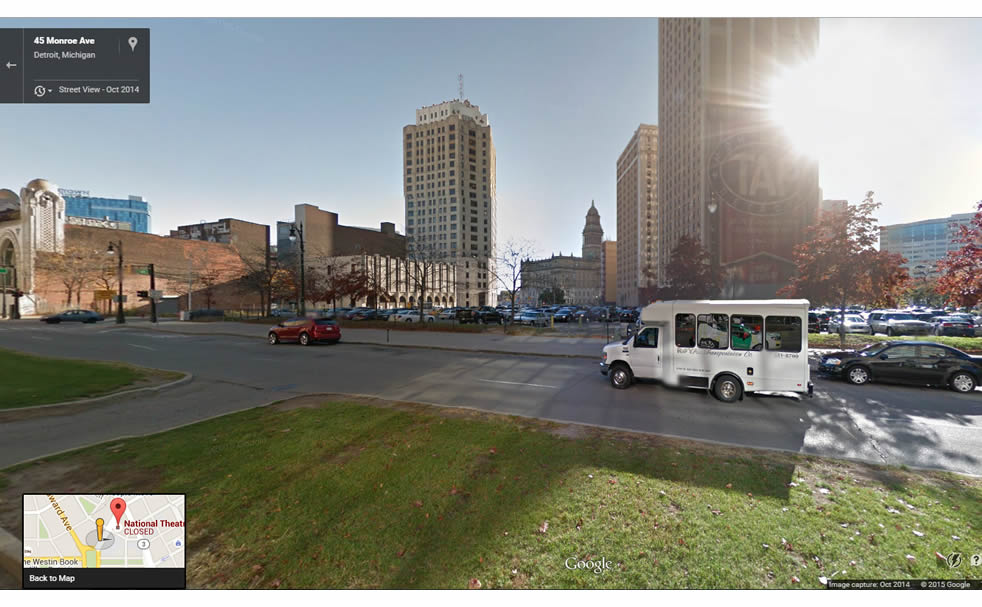Of the 256 listings on the National Register of Historic Places (NRHP) for Detroit, I find the Monroe Avenue Commercial District listing odd because only the National Theatre remains from an original listing of 13 different buildings.
Places like the Somerset Apartments, Tiger Stadium and St. Boniface Church have been removed from the list because they were demolished, but keeping one building seems to preserve the listing in this case.

One day I'll go to Detroit and walk for hours only taking exterior pictures of buildings. One day. Until then: Google StreetView.
The first buildings of the Monroe Block were constructed in 1852 at 52 through 72 Monroe Avenue. (This is across Farmer Street from where the National Theatre sits today.) These buildings were constructed by one Hiram R. Johnson, who purchased land here to construct four identical, 20-foot-wide, 4-story buildings, with a 30-foot wide, 4-story building on the end - the five buildings becoming known as the Johnson Block.
A building at 74-78 Monroe Ave was adjoined by someone other than Johnson around this time, followed by the First Williams Block coming to 32-42 Monroe Avenue in 1859.
The significance of this block & one of the reasons listed for its placement on the NRHP in 1975 was that this was one of the last commercial blocks standing in Detroit that dated to the time before the Civil War (1861).
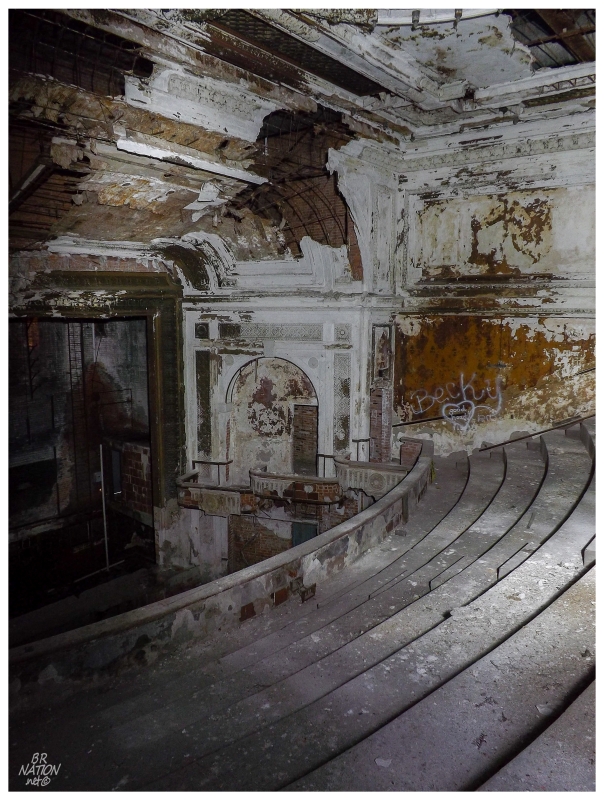
The Monroe Block also holds significance in that it was Detroit's first theatre district.
A man named William H. Klatt started this by opening a 'centodeon' in a former furniture store at 62 Monroe (Johnson Block) in 1905. While nowadays we're more familiar with the term nickelodeon, a centodeon would work where one would pay 1 cent instead of a nickel to come inside the building and watch a continuously playing film.
Just two doors down from Klatt's Theatre, John H. Kunsky opened Detroit's first proper movie house at 70-72 Monroe only a year later. This nickelodeon was known as the Casino Theatre.
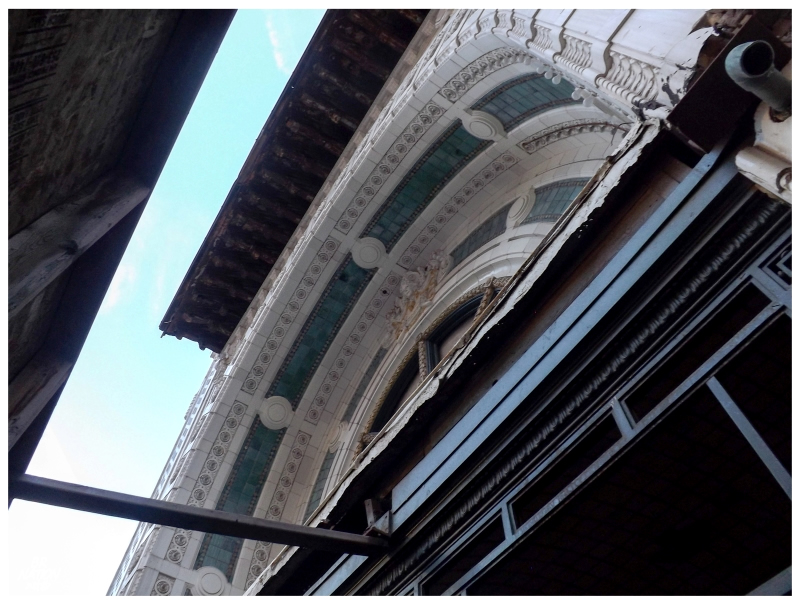
This led to William H. Klatt converting his old furniture store into a bigger theatre (The Bijou), followed by the Star Theatre being constructed on the corner of Farmer & Monroe in 1907. Kunsky then changed the face of Detroit theatre houses forever by having noted Detroit theatre architect C. Howard Crane design him the 1000 seat Columbia Theatre next to the Johnson Block at 50 Monroe. Compare this to the meagre theatre you could build on only one floor of a 20-foot wide Johnson Block building.
Finally the star of this story came along in 1911: the 800 seat National Theatre. Designed by its own important Detroit architect, Albert Kahn, where for all of the factories he designed in Metro Detroit, this is his only known theatre.
Kahn designed an exterior dominated by glazed white terra cotta, accentuated by colourful, local Pewabic tile. The American Institute of Architects guide has the theatre listed as a "hybrid Baroque-Beaux Arts-Moorish-amusement park design."
While it may look like you could miss it nowadays, long ago there was no missing the National even amongst the bustle of Monroe Ave, for both towers and the entrance arch glowed with hundreds of light bulbs, drawing attention to the theatre and away from all of the other lights, noises and roof letters of the time.
"Long View Southeast, Northwest Front of First Williams Block (Right) and Adjoining Buildings - 32-42 Monroe Ave, Manning Brothers Commercial Photographers, 1913.
Hiram R. Johnson's Johnson Block would have went from the building to the right of the Colombia Theatre, to the Chop Suey place at 74 Monroe.
Kunsky's success with the Casino and the Columbia led him to build even bigger movie theatres. The 1806 seat Madison Theatre would open in 1917, the 1770 seat Adams Theatre the same year, the Capitol (now the Detroit Opera House) opened with 3384 seats in 1922, and the claimed 4050 seats of the Michigan Theatre opened in 1926. All of these theatres were situated around Grand Circus Park, leaving the Monroe Block behind as there was a new theatre district of choice in Detroit.
Unable to compete with these grand movie palaces, Kunsky's Casino Theatre closed in 1915 and the Star Theatre by 1922. Both of these places would convert back to their original commercial configuration, with the Casino (70-72) becoming the 'Famous Barrel Bar' and the Star (100-102) becoming a host of different establishments (cigar store, jeweller, shoe store, tailor, barber, etc.)

The National Theatre couldn't convert back to a commercial structure because it never was one. With 800 seats, it could still compete and stay afloat by showing vaudeville performances instead of motion pictures.
Unfortunately it would follow the same path of so many other Detroit theatres into the 1960s and 1970s, surviving by showing adult entertainment, until this wasn't enough to keep the doors open any longer either.
In reading Kerouac's On The Road recently, there's a section where the two main characters come up to Detroit and visit one of these theatres, spending the majority of the night inside for a flat rate until they were eventually ushered out in the early hours.
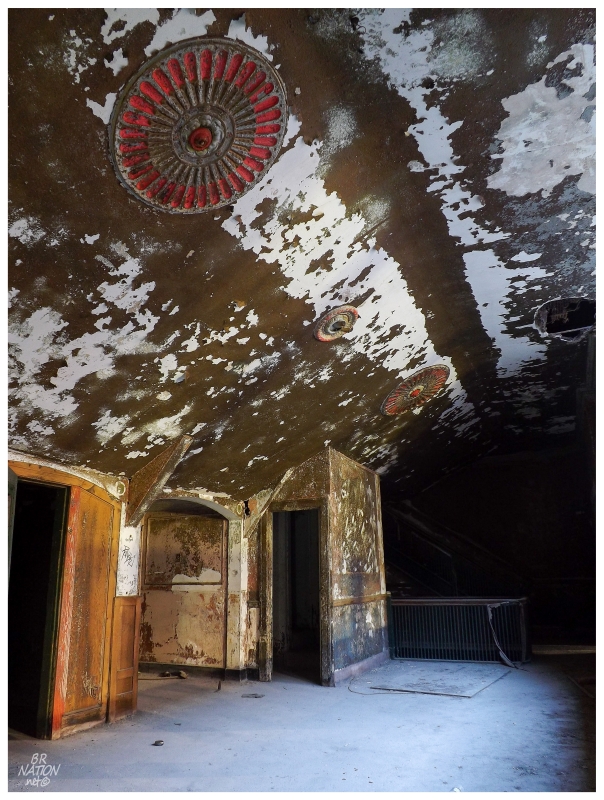
Although I knew Kerouac wasn't writing about the National because the films he mention aren't pornographic, regardless, he paints a good picture of the atmosphere you would have found inside:
"We decided to stay up in all-night movies on Skid Row. It was too cold for parks. Hassel had been here on Detroit Skid Row, he had dug every shooting gallery and all-night movie and every brawling bar with his dark eyes many a time. His ghost haunted us. We'd never find him on Times Square again. We thought maybe by accident Old Dean Moriarty was here too — but he was not. For thirty-five cents each we went into the beat-up old movie and sat down in the balcony till morning, when we were shooed downstairs. The people who were in that all-night movie were the end. Beat Negroes who'd come up from Alabama to work in car factories on a rumor; old white bums; young longhaired hipsters who'd reached the end of the road and were drinking wine; whores, ordinary couples, and housewives with nothing to do, nowhere to go, nobody to believe in."
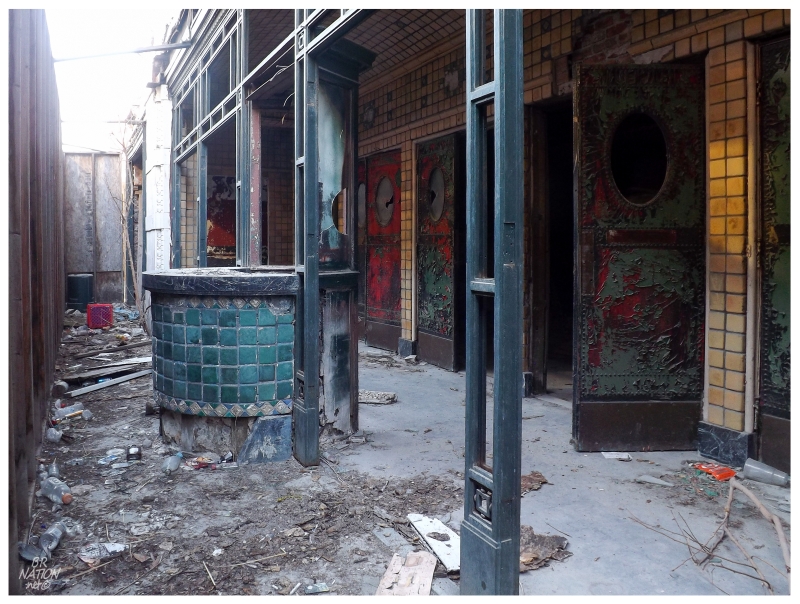
The National Theatre closed in 1975.
Sitting abandoned all of these years, the people I know that went inside, went long ago. It was always on the list of things to stop and see, but I never got around to it. It was only with seeing a glaring opening on this random day, that finally I stepped inside and took some pictures.
One of the most interesting things was behind the plywood wall which has protected the front for decades, hides a beautiful, elaborate entry area before the main doors of the theatre. Lots of people seem to be able to picture old times from standing in various interior abandoned spaces, but with the skyline mostly blocked by the 12-foot erected wall here, except for the crammed space where you'd buy your ticket, I found this to be a spot that I most easily transported back in time. Picturing walking along here with the hustle and bustle. Picturing this little piece of a time long ago, preserved here by tall plywood.
If they end up preserving only the facade as they sometimes do with small theatres, one would hope that these special columns and tiles remain somehow.
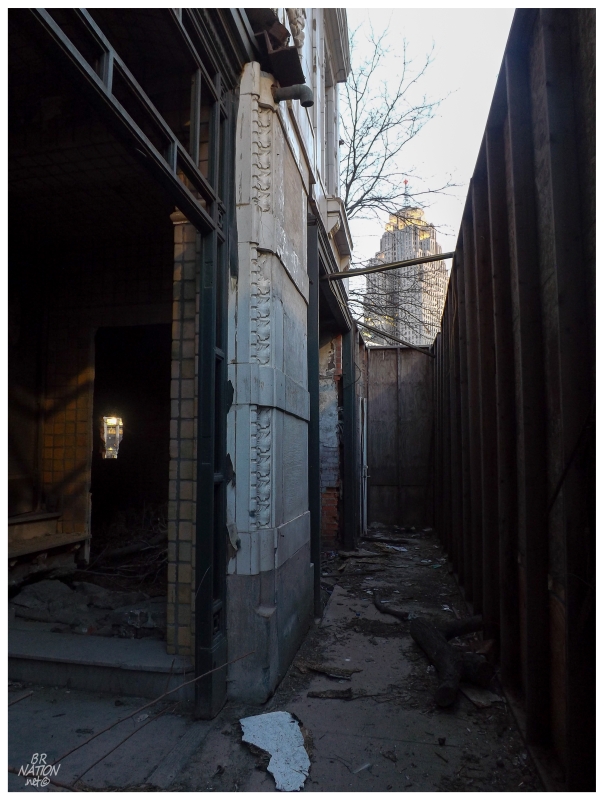
There was something special to be standing in this hidden space after walking and driving by for so many years.

My feelings changed as I went inside and moved up to the balcony to try and take a passable picture. A weird feeling of confusion came to me, in regards to how I never knew this was here and hadn't ever managed to be inside before. To be so familiar with this section of Detroit, but never have experienced this vacant space.
Of course I knew that this theatre was here for all of these years, but to actually have the square meters to myself and my cohorts for the first time, while having utilized nearby spaces hundreds of times over the years instead, was something odd.
I didn't know how I hadn't ever managed to find myself in here.
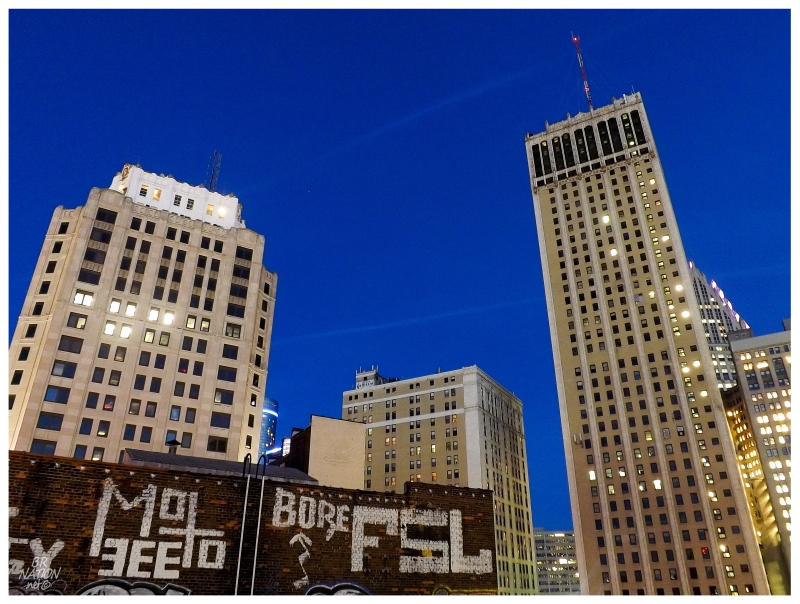
Up on the roof, I couldn't help but appreciate the fantastic view of the nearby Water Board Building. As someone who loves an unconventional choice for favourites, I've always liked and gawked at that one.
Donnie didn't quite understand in a city of Metropolitans, Guardians & Book Towers.

I couldn't believe how great this roof was as I kicked myself for procrastinating for over a decade. Not only in that I'd be upset if I never took pictures of the National before it could disappear, but also in my own selfish way of wanting to relax on this roof and take it all in for hours - something that certainly would have been more easily accomplished back in say 2007, than now in 2015.
It will get even harder in the years to come, as Schostak Bros. have acquired the land from 16 to 78 Monroe - from Farmer Street to Campus Martius - to construct a 16-story, $111 million skyscraper. (I personally wondered why a sub company would need such a skyscraper, but apparently I was thinking of Schlotzsky's. Schostak Bros. are a real estate company.) In addition, the adjacent, decades-old Bates Garage was demolished in 2013 with Dan Gilbert planning an even larger parking garage on the site.
Plans for The National have come & gone, but with the city finally snatching it back from its negligent owner, there is some talk of preserving only the facade. What will actually come of 118 Monroe is yet to be determined.

